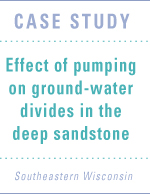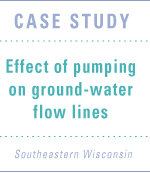
 EFFECTS OF PUMPING FROM WELLS ON GROUND-WATER DIVIDES EFFECTS OF PUMPING FROM WELLS ON GROUND-WATER DIVIDES
Pumping from wells shifts ground-water divides by redirecting
water that would ordinarily discharge
at the land surface away from the surface toward the open interval of
a well at
somedepth within the ground-water system.
For this reason pumping can move ground water under surface-water divides.
Pumping from wells moves shallow local ground-water divides that under natural conditions
approximately coincided with the topographic ridges that define
surface-water
divides:
Note that the surface-water divides are not displaced by pumping, but that the ground-water divides move in response to the new flow field.
What occurs at the scale of local ground-water flow can also occur at the regional scale. Consider the location of a regional divide that bounds ground water that is tributary to a Great Lake. Pumping can move the natural divide even if it is was originally many miles from the Lake:
Thumbnail schematic block diagrams of regional ground-water divides:

A) in the absence of pumping
|
|

C) with two pumping
centers
|
Note: The major shallow divide for ground water is approximately coincident with the topographic divide that defines the watershed boundary of the Great Lakes Basin.
(source: D.T. Feinstein, U.S. Geological Survey) |
Diagram A shows that under natural
conditions long regional flow paths move under major and
minor surface water divides and discharge toward the Lake. Pumping can
entirely reverse this
pattern and draw regional flow from beneath the Lake.
Diagram B contains a single pumping center consisting of municipal and
industrial wells. It is
inside the Great Lakes Basin (that is, east of the surface-water divide) but
draws water from
outside the Basin through long regional flow lines emanating from the other side
of the major
surface-water divide that bounds the Basin. Pumping increases the downward
leakage from
shallow local systems and fortifies regional flow.
Diagram C contains a second pumping center outside the Great Lakes Basin that
intercepts some
of the regional flow that would otherwise discharge to the first pumping center.
The competition
between pumping centers, called well interference, has a big effect on the flow
pattern.
Note how the second pumping center captures water that originates inside the
Basin by inducing
flow across the surface-water divide toward the west. Under these conditions,
precipitation and
recharge that would naturally cycle to the Lake is rerouted to a different
watershed, implying a loss
of water to the Great Lakes system.
These diagrams are relevant to the evolution
of deep ground-water flow in southeastern Wisconsin.
To next concept --> Effect
of pumping from wells on direct & indirect
ground-water flow to a Great Lake
return to top |